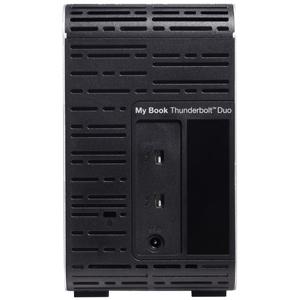Western Digital MyBook Thunderbolt Duo Review
Mike Jennings looks at the pricey 4TB hard drive, which comes with disappointing read/write speeds despite packing the high-speed Thunderbolt interface.
Thunderbolt devices promise much with theoretical bandwidth on offer. Western Digital’s MyBook Thunderbolt Duo offers a pair of these ports alongside 4TB of space. However, the use of Caviar Green hard disks, the restriction to selected Apple machines and the high price put us off, though. It is hard to image large enterprises, let alone SMBs investing in this product. Thunderbolt’s time will come, but it has a way to go yet.

Thunderbolt has had a slow start in life, despite being championed by Apple. After starting off as Intel's Light Peak, the high-speed data transfer technology has only appeared on a couple of Apple laptops and a handful of peripherals, including Western Digital's MyBook Thunderbolt Duo.
It's easy to see why Apple is pushing the Thunderbolt interface and less obvious why other companies have not started rolling it out.
Thunderbolt combines technology from PCI Express and DisplayPort connectors into a cable that's longer and cheaper than most of its rivals. Each port can work individually or as part of a group so up to seven Thunderbolt devices can be "daisy-chained" together.
Current cables don't make full use of the technology, however. To cut down on costs they're made from copper rather than the more expensive optical fibres originally proposed. This adversely affects the performance, which is seen with the MyBook.
Performance
Western Digital makes full use of the interface by offering a pair of Thunderbolt ports on the rear. Beside is the AC adapter connection. The two 2TB hard disks can be arranged in either RAID 0 or 1. The former stripes the data for improved speed, while the latter mirrors any stored data for added security, albeit with half the capacity on offer.
The firm's decision to use two Caviar Green hard disks to create the 4TB capacity on the MyBook Thunderbolt Duo appears to negate many of the advantages of Thunderbolt.

There are two Thunderbolt ports located on the back
The drives are eco-friendly and we've no complaints about the capacity or the 64MB cache afforded to each one. But their spindle speed means they can't match the sort of pace offered by traditional hard disks, which typically run at 7,200rpm.
Western Digital has calibrated each Caviar Green drive to run at the most efficient point between 5,400rpm and 7,200rpm, so you're never quite sure of the exact speed of the drive just that it won't be up to speed with standard disks.
Our file transfer benchmarks evaluated large and small file writing and reading, with a single 1.5GB file used for the former benchmarks and 15,000 100KB files used for the latter tests. The drive was configured in RAID 0, which is typically faster than RAID 1.
In our large file write test, the MyBook scored 103.08MB/s half the speed we'd expect from a typical internal hard disk. This was also slower than the 112MB/s write speed of a RAID 0, two-drive LaCie USB 3, which is rather dated.
There was little joy in our large file read test, either, with the Western Digital's 101.05MB/s result falling well short of the 141MB/s achieved by the USB 3-equipped LaCie.
Get the ITPro daily newsletter
Sign up today and you will receive a free copy of our Future Focus 2025 report - the leading guidance on AI, cybersecurity and other IT challenges as per 700+ senior executives
Mike Jennings has worked as a technology journalist for more than a decade and has been fascinated by computers since childhood, when he spent far too long building terrible websites. He loves desktop PCs, components, laptops and anything to do with the latest hardware.
Mike worked as a staff writer at PC Pro magazine in London for seven years, and during that time wrote for a variety of other tech titles, including Custom PC, Micro Mart and Computer Shopper. Since 2013, he’s been a freelance tech writer, and writes regularly for titles like Wired, TechRadar, Stuff, TechSpot, IT Pro, TrustedReviews and TechAdvisor. He still loves tech and covers everything from the latest business hardware and software to high-end gaming gear, and you’ll find him on plenty of sites writing reviews, features and guides on a vast range of topics.
You can email Mike at mike@mike-jennings.net, or find him on Twitter at @mikejjennings
-
 Global cybersecurity spending is set to rise 12% in 2025 – here are the industries ramping up investment
Global cybersecurity spending is set to rise 12% in 2025 – here are the industries ramping up investmentNews Global cybersecurity spending is expected to surge this year, fueled by escalating state-sponsored threats and the rise of generative AI, according to new analysis from IDC.
By Ross Kelly Published
-
 ‘Phishing kits are a force multiplier': Cheap cyber crime kits can be bought on the dark web for less than $25 – and experts warn it’s lowering the barrier of entry for amateur hackers
‘Phishing kits are a force multiplier': Cheap cyber crime kits can be bought on the dark web for less than $25 – and experts warn it’s lowering the barrier of entry for amateur hackersNews Research from NordVPN shows phishing kits are now widely available on the dark web and via messaging apps like Telegram, and are often selling for less than $25.
By Emma Woollacott Published
-
 Redis unveils new tools for developers working on AI applications
Redis unveils new tools for developers working on AI applicationsNews Redis has announced new tools aimed at making it easier for AI developers to build applications and optimize large language model (LLM) outputs.
By Ross Kelly Published